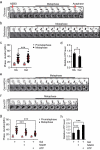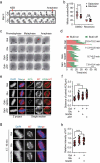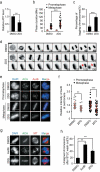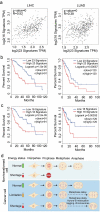Energy restriction causes metaphase delay and chromosome mis-segregation in cancer cells
- PMID: 34048314
- PMCID: PMC8265792
- DOI: 10.1080/15384101.2021.1930679
Energy restriction causes metaphase delay and chromosome mis-segregation in cancer cells
Abstract
ATP metabolism during mitosis needs to be coordinated with numerous energy-demanding activities, especially in cancer cells whose metabolic pathways are reprogramed to sustain rapid proliferation in a nutrient-deficient environment. Although strategies targeting the energy metabolic pathways have shown therapeutic efficacy in preclinical cancer models, how normal cells and cancer cells differentially respond to energy shortage is unclear. In this study, using time-lapse microscopy, we found that cancer cells displayed unique mitotic phenotypes in a dose-dependent manner upon decreasing ATP (i.e. energy) supply. When reduction in ATP concentration was moderate, chromosome movements in mitosis were barely affected, while the metaphase-anaphase transition was significantly prolonged due to reduced tension between the sister-kinetochores, which delayed the satisfaction of the spindle assembly checkpoint. Further reduction in ATP concentration led to a decreased level of Aurora-B at the centromere, resulting in increased chromosome mis-segregation after metaphase delay. In contrast to cancer cells, ATP restriction in non-transformed cells induced cell cycle arrest in interphase, rather than causing mitotic defects. In addition, data mining of cancer patient database showed a correlation between signatures of energy production and chromosomal instability possibly resulted from mitotic defects. Together, these results reveal that energy restriction induces differential responses in normal and cancer cells, with chromosome mis-segregation only observed in cancer cells. This points to targeting energy metabolism as a potentially cancer-selective therapeutic strategy.
Keywords: ATP; cancer cells; chromosome mis-segregation; energy restriction; metaphase-anaphase transition.
Conflict of interest statement
No potential conflict of interest was reported by the author(s).
Figures




Similar articles
-
Aurora B couples chromosome alignment with anaphase by targeting BubR1, Mad2, and Cenp-E to kinetochores.J Cell Biol. 2003 Apr 28;161(2):267-80. doi: 10.1083/jcb.200208091. J Cell Biol. 2003. PMID: 12719470 Free PMC article.
-
Kinetochore life histories reveal an Aurora-B-dependent error correction mechanism in anaphase.Dev Cell. 2021 Nov 22;56(22):3082-3099.e5. doi: 10.1016/j.devcel.2021.10.007. Epub 2021 Nov 9. Dev Cell. 2021. PMID: 34758290 Free PMC article.
-
Spindle checkpoint-independent inhibition of mitotic chromosome segregation by Drosophila Mps1.Mol Biol Cell. 2012 Jun;23(12):2275-91. doi: 10.1091/mbc.E12-02-0117. Epub 2012 May 2. Mol Biol Cell. 2012. PMID: 22553353 Free PMC article.
-
Recent Progress on the Localization of the Spindle Assembly Checkpoint Machinery to Kinetochores.Cells. 2019 Mar 23;8(3):278. doi: 10.3390/cells8030278. Cells. 2019. PMID: 30909555 Free PMC article. Review.
-
Detection and correction of merotelic kinetochore orientation by Aurora B and its partners.Cell Cycle. 2007 Jul 1;6(13):1558-64. doi: 10.4161/cc.6.13.4452. Epub 2007 May 18. Cell Cycle. 2007. PMID: 17603301 Review.
Cited by
-
Mitotic events depend on regulation of PLK-1 levels by the mitochondrial protein SPD-3.bioRxiv [Preprint]. 2023 Jan 12:2023.01.11.523633. doi: 10.1101/2023.01.11.523633. bioRxiv. 2023. Update in: Life Sci Alliance. 2023 Sep 8;6(11):e202302011. doi: 10.26508/lsa.202302011. PMID: 36711457 Free PMC article. Updated. Preprint.
-
Loss of the mitochondrial protein SPD-3 elevates PLK-1 levels and dysregulates mitotic events.Life Sci Alliance. 2023 Sep 8;6(11):e202302011. doi: 10.26508/lsa.202302011. Print 2023 Nov. Life Sci Alliance. 2023. PMID: 37684042 Free PMC article.
-
Targeting metabolic vulnerability by combining NAMPT inhibitors and disulfiram for treatment of recurrent ovarian cancer.Cell Death Dis. 2025 Apr 25;16(1):342. doi: 10.1038/s41419-025-07672-3. Cell Death Dis. 2025. PMID: 40280967 Free PMC article.
References
-
- Jia L, Kim S, Yu H.. Tracking spindle checkpoint signals from kinetochores to APC/C. Trends Biochem Sci. 2013;38(6):302–311. - PubMed
-
- Skog S, Tribukait B, Sundius G. Energy metabolism and ATP turnover time during the cell cycle of Ehrlich ascites tumour cells. Exp Cell Res. 1982;141:23–29. - PubMed
-
- Salazar-Roa M, Malumbres M. Fueling the cell division cycle. Trends Cell Biol. 2017;27:69–81. - PubMed
-
- Harbauer AB, Opalińska M, Gerbeth C, et al. Mitochondria. Cell cycle-dependent regulation of mitochondrial preprotein translocase. Science. 2014;346:1109–1113. - PubMed
Publication types
MeSH terms
Substances
LinkOut - more resources
Full Text Sources
Other Literature Sources
Medical
Miscellaneous
